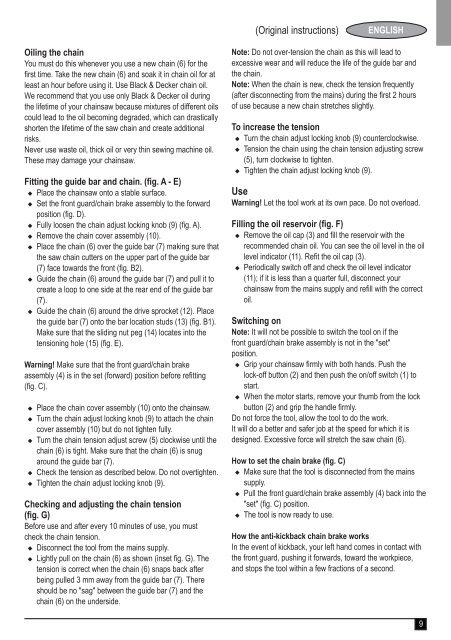BlackandDecker Tronconneuse- Gk2235 - Type 3 - Instruction Manual (Européen)
BlackandDecker Tronconneuse- Gk2235 - Type 3 - Instruction Manual (Européen)
BlackandDecker Tronconneuse- Gk2235 - Type 3 - Instruction Manual (Européen)
You also want an ePaper? Increase the reach of your titles
YUMPU automatically turns print PDFs into web optimized ePapers that Google loves.
(Original instructions)<br />
ENGLISH<br />
Oiling the chain<br />
You must do this wh<strong>en</strong>ever you use a new chain (6) for the<br />
first time. Take the new chain (6) and soak it in chain oil for at<br />
least an hour before using it. Use Black & Decker chain oil.<br />
We recomm<strong>en</strong>d that you use only Black & Decker oil during<br />
the lifetime of your chainsaw because mixtures of differ<strong>en</strong>t oils<br />
could lead to the oil becoming degraded, which can drastically<br />
short<strong>en</strong> the lifetime of the saw chain and create additional<br />
risks.<br />
Never use waste oil, thick oil or very thin sewing machine oil.<br />
These may damage your chainsaw.<br />
Fitting the guide bar and chain. (fig. A - E)<br />
u Place the chainsaw onto a stable surface.<br />
u Set the front guard/chain brake assembly to the forward<br />
position (fig. D).<br />
u Fully loos<strong>en</strong> the chain adjust locking knob (9) (fig. A).<br />
u Remove the chain cover assembly (10).<br />
u Place the chain (6) over the guide bar (7) making sure that<br />
the saw chain cutters on the upper part of the guide bar<br />
(7) face towards the front (fig. B2).<br />
u Guide the chain (6) around the guide bar (7) and pull it to<br />
create a loop to one side at the rear <strong>en</strong>d of the guide bar<br />
(7).<br />
u Guide the chain (6) around the drive sprocket (12). Place<br />
the guide bar (7) onto the bar location studs (13) (fig. B1).<br />
Make sure that the sliding nut peg (14) locates into the<br />
t<strong>en</strong>sioning hole (15) (fig. E).<br />
Warning! Make sure that the front guard/chain brake<br />
assembly (4) is in the set (forward) position before refitting<br />
(fig. C).<br />
u Place the chain cover assembly (10) onto the chainsaw.<br />
u Turn the chain adjust locking knob (9) to attach the chain<br />
cover assembly (10) but do not tight<strong>en</strong> fully.<br />
u Turn the chain t<strong>en</strong>sion adjust screw (5) clockwise until the<br />
chain (6) is tight. Make sure that the chain (6) is snug<br />
around the guide bar (7).<br />
u Check the t<strong>en</strong>sion as described below. Do not overtight<strong>en</strong>.<br />
u Tight<strong>en</strong> the chain adjust locking knob (9).<br />
Checking and adjusting the chain t<strong>en</strong>sion<br />
(fig. G)<br />
Before use and after every 10 minutes of use, you must<br />
check the chain t<strong>en</strong>sion.<br />
u Disconnect the tool from the mains supply.<br />
u Lightly pull on the chain (6) as shown (inset fig. G). The<br />
t<strong>en</strong>sion is correct wh<strong>en</strong> the chain (6) snaps back after<br />
being pulled 3 mm away from the guide bar (7). There<br />
should be no "sag" betwe<strong>en</strong> the guide bar (7) and the<br />
chain (6) on the underside.<br />
Note: Do not over-t<strong>en</strong>sion the chain as this will lead to<br />
excessive wear and will reduce the life of the guide bar and<br />
the chain.<br />
Note: Wh<strong>en</strong> the chain is new, check the t<strong>en</strong>sion frequ<strong>en</strong>tly<br />
(after disconnecting from the mains) during the first 2 hours<br />
of use because a new chain stretches slightly.<br />
To increase the t<strong>en</strong>sion<br />
u Turn the chain adjust locking knob (9) counterclockwise.<br />
u T<strong>en</strong>sion the chain using the chain t<strong>en</strong>sion adjusting screw<br />
(5), turn clockwise to tight<strong>en</strong>.<br />
u Tight<strong>en</strong> the chain adjust locking knob (9).<br />
Use<br />
Warning! Let the tool work at its own pace. Do not overload.<br />
Filling the oil reservoir (fig. F)<br />
u Remove the oil cap (3) and fill the reservoir with the<br />
recomm<strong>en</strong>ded chain oil. You can see the oil level in the oil<br />
level indicator (11). Refit the oil cap (3).<br />
u Periodically switch off and check the oil level indicator<br />
(11); if it is less than a quarter full, disconnect your<br />
chainsaw from the mains supply and refill with the correct<br />
oil.<br />
Switching on<br />
Note: It will not be possible to switch the tool on if the<br />
front guard/chain brake assembly is not in the "set"<br />
position.<br />
u Grip your chainsaw firmly with both hands. Push the<br />
lock-off button (2) and th<strong>en</strong> push the on/off switch (1) to<br />
start.<br />
u Wh<strong>en</strong> the motor starts, remove your thumb from the lock<br />
button (2) and grip the handle firmly.<br />
Do not force the tool, allow the tool to do the work.<br />
It will do a better and safer job at the speed for which it is<br />
designed. Excessive force will stretch the saw chain (6).<br />
How to set the chain brake (fig. C)<br />
u Make sure that the tool is disconnected from the mains<br />
supply.<br />
u Pull the front guard/chain brake assembly (4) back into the<br />
"set" (fig. C) position.<br />
u The tool is now ready to use.<br />
How the anti-kickback chain brake works<br />
In the ev<strong>en</strong>t of kickback, your left hand comes in contact with<br />
the front guard, pushing it forwards, toward the workpiece,<br />
and stops the tool within a few fractions of a second.<br />
9
















